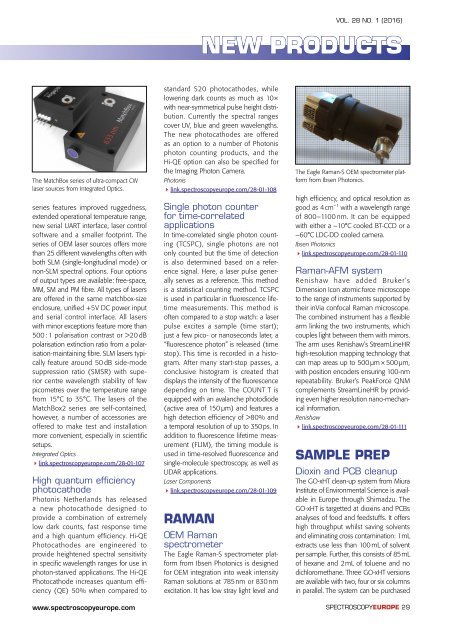Raman spectroscopy of biological pigments Solid mixed matrices in MALDI/TOF-MS
1VpTi1r
1VpTi1r
You also want an ePaper? Increase the reach of your titles
YUMPU automatically turns print PDFs into web optimized ePapers that Google loves.
VOL. 28 NO. 1 (2016)<br />
NEW PRODUCTS<br />
The MatchBox series <strong>of</strong> ultra-compact CW<br />
laser sources from Integrated Optics.<br />
series features improved ruggedness,<br />
extended operational temperature range,<br />
new serial UART <strong>in</strong>terface, laser control<br />
s<strong>of</strong>tware and a smaller footpr<strong>in</strong>t. The<br />
series <strong>of</strong> OEM laser sources <strong>of</strong>fers more<br />
than 25 different wavelengths <strong>of</strong>ten with<br />
both SLM (s<strong>in</strong>gle-longitud<strong>in</strong>al mode) or<br />
non-SLM spectral options. Four options<br />
<strong>of</strong> output types are available: free-space,<br />
MM, SM and PM fibre. All types <strong>of</strong> lasers<br />
are <strong>of</strong>fered <strong>in</strong> the same matchbox-size<br />
enclosure, unified +5 V DC power <strong>in</strong>put<br />
and serial control <strong>in</strong>terface. All lasers<br />
with m<strong>in</strong>or exceptions feature more than<br />
500 : 1 polarisation contrast or >20 dB<br />
polarisation ext<strong>in</strong>ction ratio from a polarisation-ma<strong>in</strong>ta<strong>in</strong><strong>in</strong>g<br />
fibre. SLM lasers typically<br />
feature around 50 dB side-mode<br />
suppression ratio (S<strong>MS</strong>R) with superior<br />
centre wavelength stability <strong>of</strong> few<br />
picometres over the temperature range<br />
from 15°C to 35°C. The lasers <strong>of</strong> the<br />
MatchBox2 series are self-conta<strong>in</strong>ed,<br />
however, a number <strong>of</strong> accessories are<br />
<strong>of</strong>fered to make test and <strong>in</strong>stallation<br />
more convenient, especially <strong>in</strong> scientific<br />
setups.<br />
Integrated Optics<br />
l<strong>in</strong>k.<strong>spectroscopy</strong>europe.com/28-01-107<br />
<br />
High quantum efficiency<br />
photocathode<br />
Photonis Netherlands has released<br />
a new photocathode designed to<br />
provide a comb<strong>in</strong>ation <strong>of</strong> extremely<br />
low dark counts, fast response time<br />
and a high quantum efficiency. Hi-QE<br />
Photocathodes are eng<strong>in</strong>eered to<br />
provide heightened spectral sensitivity<br />
<strong>in</strong> specific wavelength ranges for use <strong>in</strong><br />
photon-starved applications. The Hi-QE<br />
Photocathode <strong>in</strong>creases quantum efficiency<br />
(QE) 50% when compared to<br />
standard S20 photocathodes, while<br />
lower<strong>in</strong>g dark counts as much as 10×<br />
with near-symmetrical pulse height distribution.<br />
Currently the spectral ranges<br />
cover UV, blue and green wavelengths.<br />
The new photocathodes are <strong>of</strong>fered<br />
as an option to a number <strong>of</strong> Photonis<br />
photon count<strong>in</strong>g products, and the<br />
Hi-QE option can also be specified for<br />
the Imag<strong>in</strong>g Photon Camera.<br />
Photonis<br />
l<strong>in</strong>k.<strong>spectroscopy</strong>europe.com/28-01-108<br />
<br />
S<strong>in</strong>gle photon counter<br />
for time-correlated<br />
applications<br />
In time-correlated s<strong>in</strong>gle photon count<strong>in</strong>g<br />
(TCSPC), s<strong>in</strong>gle photons are not<br />
only counted but the time <strong>of</strong> detection<br />
is also determ<strong>in</strong>ed based on a reference<br />
signal. Here, a laser pulse generally<br />
serves as a reference. This method<br />
is a statistical count<strong>in</strong>g method. TCSPC<br />
is used <strong>in</strong> particular <strong>in</strong> fluorescence lifetime<br />
measurements. This method is<br />
<strong>of</strong>ten compared to a stop watch: a laser<br />
pulse excites a sample (time start);<br />
just a few pico- or nanoseconds later, a<br />
“fluorescence photon” is released (time<br />
stop). This time is recorded <strong>in</strong> a histogram.<br />
After many start-stop passes, a<br />
conclusive histogram is created that<br />
displays the <strong>in</strong>tensity <strong>of</strong> the fluorescence<br />
depend<strong>in</strong>g on time. The COUNT T is<br />
equipped with an avalanche photodiode<br />
(active area <strong>of</strong> 150 µm) and features a<br />
high detection efficiency <strong>of</strong> >80% and<br />
a temporal resolution <strong>of</strong> up to 350 ps. In<br />
addition to fluorescence lifetime measurement<br />
(FLIM), the tim<strong>in</strong>g module is<br />
used <strong>in</strong> time-resolved fluorescence and<br />
s<strong>in</strong>gle-molecule <strong>spectroscopy</strong>, as well as<br />
LIDAR applications.<br />
Laser Components<br />
l<strong>in</strong>k.<strong>spectroscopy</strong>europe.com/28-01-109<br />
<br />
RAMAN<br />
OEM <strong>Raman</strong><br />
spectrometer<br />
The Eagle <strong>Raman</strong>-S spectrometer platform<br />
from Ibsen Photonics is designed<br />
for OEM <strong>in</strong>tegration <strong>in</strong>to weak <strong>in</strong>tensity<br />
<strong>Raman</strong> solutions at 785 nm or 830 nm<br />
excitation. It has low stray light level and<br />
The Eagle <strong>Raman</strong>-S OEM spectrometer platform<br />
from Ibsen Photonics.<br />
high efficiency, and optical resolution as<br />
good as 4 cm –1 with a wavelength range<br />
<strong>of</strong> 800–1100 nm. It can be equipped<br />
with either a –10°C cooled BT-CCD or a<br />
–60°C LDC-DD cooled camera.<br />
Ibsen Photonics<br />
l<strong>in</strong>k.<strong>spectroscopy</strong>europe.com/28-01-110<br />
<br />
<strong>Raman</strong>-AFM system<br />
Renishaw have added Bruker’s<br />
Dimension Icon atomic force microscope<br />
to the range <strong>of</strong> <strong>in</strong>struments supported by<br />
their <strong>in</strong>Via confocal <strong>Raman</strong> microscope.<br />
The comb<strong>in</strong>ed <strong>in</strong>strument has a flexible<br />
arm l<strong>in</strong>k<strong>in</strong>g the two <strong>in</strong>struments, which<br />
couples light between them with mirrors.<br />
The arm uses Renishaw’s StreamL<strong>in</strong>eHR<br />
high-resolution mapp<strong>in</strong>g technology that<br />
can map areas up to 500 µm × 500 µm,<br />
with position encoders ensur<strong>in</strong>g 100-nm<br />
repeatability. Bruker’s PeakForce QNM<br />
complements StreamL<strong>in</strong>eHR by provid<strong>in</strong>g<br />
even higher resolution nano-mechanical<br />
<strong>in</strong>formation.<br />
Renishaw<br />
l<strong>in</strong>k.<strong>spectroscopy</strong>europe.com/28-01-111<br />
<br />
SAMPLE PREP<br />
Diox<strong>in</strong> and PCB cleanup<br />
The GO-xHT clean-up system from Miura<br />
Institute <strong>of</strong> Environmental Science is available<br />
<strong>in</strong> Europe through Shimadzu. The<br />
GO-xHT is targetted at diox<strong>in</strong>s and PCBs<br />
analyses <strong>of</strong> food and feedstuffs. It <strong>of</strong>fers<br />
high throughput whilst sav<strong>in</strong>g solvents<br />
and elim<strong>in</strong>at<strong>in</strong>g cross contam<strong>in</strong>ation: 1 mL<br />
extracts use less than 100 mL <strong>of</strong> solvent<br />
per sample. Further, this consists <strong>of</strong> 85 mL<br />
<strong>of</strong> hexane and 2 mL <strong>of</strong> toluene and no<br />
dichloromethane. Three GO-xHT versions<br />
are available with two, four or six columns<br />
<strong>in</strong> parallel. The system can be purchased<br />
www.<strong>spectroscopy</strong>europe.com<br />
SPECTROSCOPYEUROPE 29


